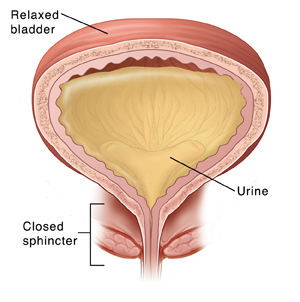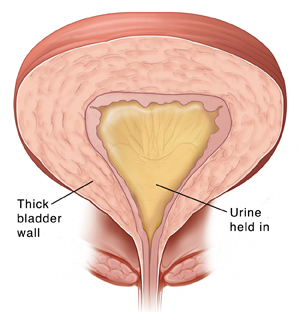When Your Child Has Neurogenic Bladder
When Your Child Has Neurogenic Bladder
Your child has been diagnosed with neurogenic bladder. This is a problem with the nerves that carry signals to and from your child’s bladder. It can lead to trouble with holding or releasing urine. Neurogenic bladder can be managed. Your child’s healthcare provider will tell you more about options for your child.
|
What is neurogenic bladder?
Normally, nerves carry messages back and forth between the bladder and the brain. The nerves tell the brain when the bladder is full. The brain then sends signals, telling the bladder muscles to hold or release urine. With neurogenic bladder, the messages aren’t being sent or received properly. This can lead to problems with bladder control.
What causes neurogenic bladder?
Damage to nerves may be caused by the following:
Nerve problems that are present at birth (congenital), such as spina bifida
Injury to or infection of the brain or spinal cord
What are the signs?
These are the signs of neurogenic bladder:
Trouble holding or releasing urine
Failure to potty train
Urinary tract infection (UTI)
Swollen kidneys or other congenital urinary problems
Thickened bladder wall
How is neurogenic bladder diagnosed?
Neurogenic bladder is often suspected in children with conditions or injuries affecting the brain or spinal cord. Your healthcare provider will ask you about your child’s health. A physical exam will also be done to look for problems and observe urination. To help get more information:
Urine tests may be done to detect an infection and protein in the urine. Protein in urine can be a sign of kidney disease.
You may be asked to keep a record of your child’s voiding habits.
A kidney and bladder ultrasound may be used to check for swelling of the kidneys and look at the bladder.
A urodynamics study may be done to give the healthcare provider a detailed look at how well your child’s bladder and urethra work.
How is neurogenic bladder treated?
Treatment depends on the cause of your child’s neurogenic bladder and what type of voiding problem he or she has. Your child may need one or more of the following treatments:
Timed voiding, which means using the toilet at regularly scheduled times. It can help your child avoid wetting accidents and protect the kidneys.
Intermittent catheterization to drain the bladder on a regular schedule. It involves inserting and removing a tube (catheter) through the urethra into the bladder each time it needs to be emptied.
For some injuries, a more permanent catheter placement called an indwelling catheter is needed.
Medicine to relax the bladder muscles and prevent muscle spasm (involuntary tightening of muscles).
Surgery to protect the kidneys and allow for continence (the controlled holding in and releasing of urine and stool). Surgery may be done to:
Create a new opening in the belly through which a temporary catheter can be placed to empty the bladder
Make the bladder larger
Tighten the sphincter so it can better hold in urine
Your child’s healthcare provider can discuss surgery with you, if it is an option.
Timed voiding
Timed voiding means urinating at scheduled times. It allows kids who are potty trained to empty their bladders on a regular basis. This helps prevent infections and avoid wetting accidents. To practice timed voiding, your child will need to visit the bathroom at set times throughout the day. His or her healthcare provider can suggest how often your child should urinate. Your child should NOT wait until the urge to urinate arises before using the toilet.
What are the long-term concerns?
Left untreated, children with this condition are likely to have bladder and kidney problems. Constipation and the inability to hold in stool may also be more likely. Steps can be taken to help with these problems. Your child’s healthcare provider can discuss your child’s condition with you and how your child is likely to progress long-term. Also, the condition may change over time so it will need to be monitored throughout your child’s lifetime.
Coping
Dealing with neurogenic bladder can be difficult to cope with. Incontinence can also cause embarrassment and lead to self-esteem issues for your child. It’s vital for your child’s treatment and emotional development that you be supportive and patient. It takes work and time to learn how to best manage your child’s condition. Encourage your child’s success by seeing to it that he or she follows the treatment plan. In some cases, a psychological therapist can help the child and family follow the treatment plan.
Learning more
If you have questions, talk to your child’s care team. Also, look for support materials in your local library or bookstore. These online resources can also be helpful:
National Association for Continence www.nafc.org
Spina Bifida Association www.spinabifidaassociation.org
Updated:
March 21, 2017
Sources:
The Merck Manual Congenital Neurogenic Bladder, The Merck Manual Neurogenic Bladder
Reviewed By:
Adler, Liora, C., MD,Bass, Pat F., III, MD, MPH,Image reviewed by StayWell medical illustration team.

